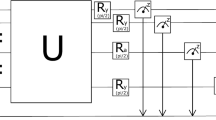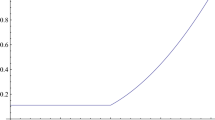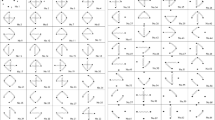Abstract
It is known that there are three maximally entangled states \(|\varPhi _1 \rangle = (|0000 \rangle + |1111 \rangle ) / \sqrt{2}\), \(|\varPhi _2 \rangle = (\sqrt{2} |1111 \rangle + |1000 \rangle + |0100 \rangle + |0010 \rangle + |0001 \rangle ) / \sqrt{6}\), and \(|\varPhi _3 \rangle = (|1111 \rangle + |1100 \rangle + |0010 \rangle + |0001 \rangle ) / 2\) in four-qubit system. It is also known that there are three independent measures \(\mathcal{F}^{(4)}_j (j=1,2,3)\) for true four-way quantum entanglement in the same system. In this paper, we compute \(\mathcal{F}^{(4)}_j\) and their corresponding linear monotones \(\mathcal{G}^{(4)}_j\) for three rank-two mixed states \(\rho _j = p |\varPhi _j \rangle \langle \varPhi _j | + (1 - p) |\text{ W }_4 \rangle \langle \text{ W }_4 |\), where \(|\text{ W }_4 \rangle = (|0111 \rangle + |1011 \rangle + |1101 \rangle + |1110 \rangle ) / 2\). We discuss the possible applications of our results briefly.


Similar content being viewed by others
Notes
The current status of quantum computer technology was reviewed in Ref. [8].
For complete proof on the connection between SLOCC and local operations, see Appendix A of Ref. [27].
In this paper, we will call \(\tau _3\) three-tangle and \(\tau _3^2\) residual entanglement.
The parameter \(p_1\) is obtained by an equation \(6 p_1 (4 p_1 - 3)^2 = (1 - p_1) (1 + 2 p_1)^2\).
References
Nielsen, M.A., Chuang, I.L.: Quantum computation and quantum information. Cambridge University Press, Cambridge, (2000)
Horodecki, R., Horodecki, P., Horodecki, M., Horodecki, K.: Quantum entanglement. Rev. Mod. Phys. 81, 865 (2009). quant-ph/0702225 and references therein
Bennett, C.H., Brassard, G., Crepeau, C., Jozsa, R., Peres, A., Wootters, W.K.: Teleporting an unknown quantum state via dual classical and Einstein–Podolsky–Rosen channles. Phys. Rev. Lett. 70, 1895 (1993)
Bennett, C.H., Wiesner, S.J.: Communication via one- and two-particle operators on Einstein–Podolsky–Rosen states. Phys. Rev. Lett. 69, 2881 (1992)
Scarani, V., Lblisdir, S., Gisin, N., Acin, A.: Quantum cloning. Rev. Mod. Phys. 77, 1225 (2005). quant-ph/0511088 and references therein
Ekert, A.K.: Quantum cryptography based on bells theorem. Phys. Rev. Lett. 67, 661 (1991)
Kollmitzer, C., Pivk, M.: Applied Quantum Cryptography. Springer, Heidelberg, (2010)
Ladd, T.D., Jelezko, F., Laflamme, R., Nakamura, Y., Monroe, C., O’Brien, J.L.: Quantum computers. Nature 464, 45 (2010). arXiv:1009.2267 (quant-ph)
Vidal, G.: Efficient classical simulation of slightly entangled quantum computations. Phys. Rev. Lett. 91, 147902 (2003). quant-ph/0301063
Bennett, C.H., DiVincenzo, D.P., Smokin, J.A., Wootters, W.K.: Mixed-state entanglement and quantum error correction. Phys. Rev. A 54, 3824 (1996). quant-ph/9604024
Vedral, V., Plenio, M.B., Rippin, M.A., Knight, P.L.: Quantifying entanglement. Phys. Rev. Lett. 78, 2275 (1997). quant-ph/9702027
Vedral, V., Plenio, M.B.: Entanglement measures and purification procedures. Phys. Rev. 57, 1619 (1998). quant-ph/9707035
Smolin, J.A.: Four-party unlockable bound entangled state. Phys. Rev. A. 63, 032306 (2001). quant-ph/0001001
Ghosh, S., Kar, G., Roy, A., Sen(De), A., Sen, U.: Distinguishability of bell states. Phys. Rev. Lett. 87, 277902 (2001). quant-ph/0106148
Chen, Y.X., Jin, J.S., Yang, D.: Distillation of multiple copies of bell states. Phys. Rev. A. 67, 014302 (2003)
Yang, D., Chen, Y.X.: Mixture of multiple copies of maximally entangled states is quasipure. Phys. Rev. A 69, 024302 (2004)
Miranowicz, A., Ishizaka, S.: Closed formula for the relative entropy of entanglement. Phys. Rev. A 78, 032310 (2008). arXiv:0805.3134 (quant-ph)
Kim, H., Hwang, M.R., Jung, E., Park, D.K.: Difficulties in analytic computation for relative entropy of entanglement. ibid. A 81, 052325 (2010). arXiv:1002.4695 (quant-ph)
Park, D.K.: Relative entropy of entanglement for two-qubit state with \(z\)-directional Bloch vectors. Int. J. Quantum. Inf. 8, 869 (2010). arXiv:1005.4777 (quant-ph)
Friedland, S., Gour, G.: Closed formula for the relative entropy of entanglement in all dimensions. J. Math. Phys. 52, 052201 (2011). arXiv:1007.4544 (quant-ph)
M. W. Girard, G. Gour, and S. Friedland, On convex optimization problems in quantum information theory. arXiv:1402.0034 (quant-ph)
Jung, E., Park, D.K.: REE From EOF. Quantum. Inf. Process. 14, 531 (2015). arXiv:1404.7708 (quant-ph)
Uhlmann, A.: Fidelity and concurrence of conjugate states. Phys. Rev. 62, 032307 (2000). quant-ph/9909060
Hill, S., Wootters, W.K.: Entanglement of a pair of quantum bits. Phys. Rev. Lett. 78, 5022 (1997). quant-ph/9703041
W. K. Wootters, Entanglement of formation of an arbitrary state of two qubits. ibid. 80 2245 (1998) quant-ph/9709029
Bennett, C.H., Popescu, S., Rohrlich, D., Smolin, J.A., Thapliyal, A.V.: Exact and asymptotic measures of multipartite pure-state entanglement. Phys. Rev. 63, 012307 (2000). quant-ph/9908073
Dür, W., Vidal, G., Cirac, J.I.: Three qubits can be entangled in two inequivalent ways. Phys. Rev. A 62, 062314 (2000). quant-ph/0005115
Acín, A., Bruß, D., Lewenstein, M., Sanpera, A.: Classification of mixed three-qubit states. Phys. Rev. Lett. 87, 040401 (2001). quant-ph/0103025
Verstraete, F., Dehaene, J., De Moor, D.: Normal forms and entanglement measures for multipartite quantum states. Phys. Rev. A 68, 012103 (2003). quant-ph/0105090
Coffman, V., Kundu, J., Wootters, W.K.: Distributed entanglement. Phys. Rev. A 61, 052306 (2000). quant-ph/9907047
Lohmayer, R., Osterloh, A., Siewert, j, Uhlmann, A.: Entangled three-qubit states without concurrence and three-tangle. Phys. Rev. Lett. 97, 260502 (2006). quant-ph/0606071
Eltschka, C., Osterloh, A., Siewert, J., Uhlmann, A.: Three-tangle for mixtures of generalized GHZ and generalized W states. New J. Phys. 10, 043014 (2008). arXiv:0711.4477 (quant-ph)
Jung, E., Hwang, M.R., Park, D.K., Son, J.W.: Three-tangle for rank-3 mixed states: mixture of Greenberger–Horne–Zeilinger, W and flipped W states. Phys. Rev. A 79, 024306 (2009). arXiv:0810.5403 (quant-ph)
Jung, E., Park, D.K., Son, J.W.: Three-tangle does not properly quantify tripartite entanglement for Greenberger–Horne–Zeilinger-type state. Phys. Rev. A 80, 010301(R) (2009). arXiv:0901.2620 (quant-ph)
Jung, E., Hwang, M.R., Park, D.K., Tamaryan, S.: Three-party entanglement in tripartite teleportation scheme through noisy channels. Quantum Inf. Comput. 10, 0377 (2010). arXiv:0904.2807 (quant-ph)
Eltschka, C., Siewert, J.: Entanglement of three-qubit Greenberger–Horne–Zeilinger-symmetric states. Phys. Rev. Lett. 108, 020502 (2012). arXiv:1304.6095 (quant-ph)
Siewert, J., Eltschka, C.: Quantifying tripartite entanglement of three-qubit generalized werner states. Phys. Rev. Lett. 108, 230502 (2012)
Osterloh, A., Siewert, J.: Constructing N-qubit entanglement monotones from antilinear operators. Phys. Rev. A 72, 012337 (2005). quant-ph/0410102
Doković, D.Ž., Osterloh, A.: On polynomial invariants of several qubits. J. Math. Phys. 50, 033509 (2009). arXiv:0804.1661 (quant-ph)
Osterloh, A., Siewert, J.: The invariant-comb approach and its relation to the balancedness of multiple entangled states. New J. Phys. 12, 075025 (2010). arXiv:0908.3818 (quant-ph)
Osterloh, A., Siewert, J.: Entanglement monotones and maximally entangled states in multipartite qubit systems. Inf. Comput. 4, 0531 (2006). quant-ph/0506073
Verstraete, F., Dehaene, J., De Moor, B., Verschelde, H.: Four qubits can be entangled in nine different ways. Phys. Rev. A 65, 052112 (2002)
Osterloh, A., Siewert, J., Uhlmann, A.: Tangles of superpositions and the convex-roof extension. Phys. Rev. A 77, 032310 (2008). arXiv:0710.5909 (quant-ph)
Hiriart-Urruty, J.-B., Lemaréchal, C.L.: Convex Analysis and Minimization Algorithms. Springer, Berlin, (1996)
C. Eltschka and J. Siewert, Monogamy equalities for qubit entanglement from Lorentz invariance. arXiv:1407.8195 (quant-ph)
Acknowledgments
This research was supported by the Basic Science Research Program through the National Research Foundation of Korea(NRF) funded by the Ministry of Education, Science and Technology(2011-0011971).
Author information
Authors and Affiliations
Corresponding author
Rights and permissions
About this article
Cite this article
Jung, E., Park, D. Entanglement of four-qubit rank-2 mixed states. Quantum Inf Process 14, 3317–3333 (2015). https://doi.org/10.1007/s11128-015-1039-4
Received:
Accepted:
Published:
Issue Date:
DOI: https://doi.org/10.1007/s11128-015-1039-4




